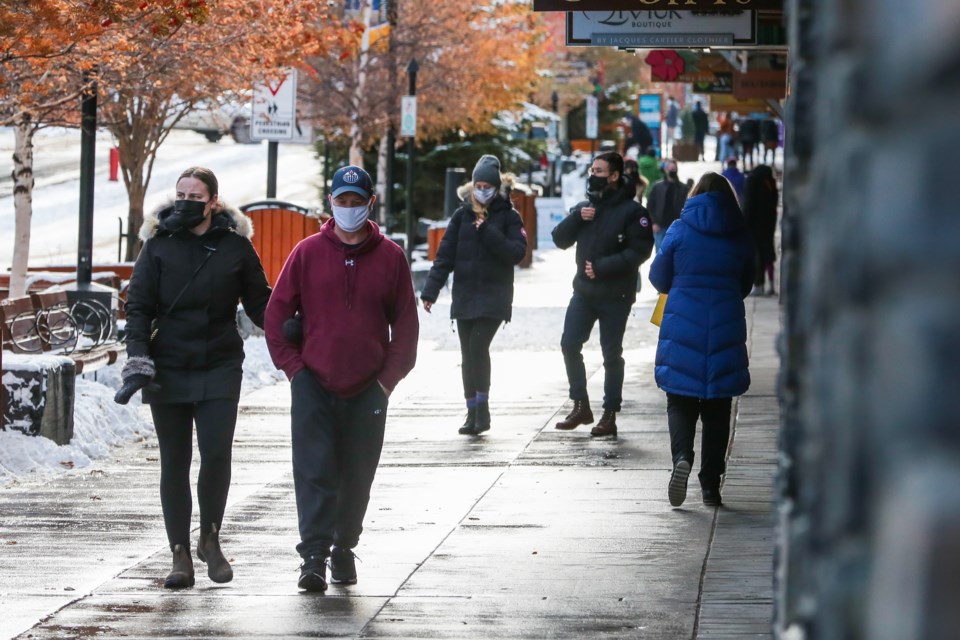BANFF – The number of positive COVID-19 cases in the Bow Valley has jumped to 79 in the past 24 hours.
The increase, announced on Wednesday (Nov. 18), is due to a rise in cases in Banff National Park, which includes the communities of Banff and Lake Louise, from 50 to 60. Canmore dropped from 16 cases to 15 cases and the MD of Bighorn remains at four cases.
However, Banff’s Emergency Coordination Centre (ECC) is asking local businesses to also report any positive cases directly to the ECC to assist in verifying case counts provided through the provincial reporting system.
Officials say it has come to the ECC’s attention that there may be a glitch tied to local case reporting for any temporary residents who provide a health care card that is not affiliated with Banff addresses - meaning case counts may in fact be higher.
Banff Lake Louise Tourism has sent out an email to businesses on behalf of the ECC asking for the community’s help in order to fully understand the extent of the case count in Banff National Park.
“We continue to do whatever is necessary to help ensure our destination remains open and that we are able to safely welcome visitors,” said Leslie Bruce, president and CEO of Banff and Lake Louise Tourism.
“In order to ensure informed decisions are made, the ECC is asking for your help to understand the full picture in terms of positive COVID-19 cases,” said Bruce, adding no names are being requested, just case numbers reported to businesses by their staff.
According to the latest provincial numbers, there were 732 new cases of the virus identified province-wide from Nov. 17 to Nov. 18, for a total 10,057 active cases in Alberta.
“I continue to be concerned about these numbers as the human costs of COVID are rising rapidly,” said Dr. Deena Hinshaw, Alberta’s chief medical officer of health.
Currently, there are 287 people in hospital across the province, with 57 of those patients in intensive care units.
In the past 24 hours, 11 more people died, bringing the the provincial COVID death toll since the pandemic began to 443.
Hinshaw said almost a quarter of all the province’s COVID-19 deaths have happened since Nov. 1.
“If we do not change our trajectory, the implications are grim,” she said.
“The daily COVID-19 death count is a tragic reminder that COVID-19 is not just a flu; it is life and death.”
As COVID-19 cases continue to rise provincially, there is a corresponding rise in people being admitted to hospital, including intensive care units.
It’s also leading to an increase in the number of frontline health care workers who are off work because of a potential COVID-19 exposure and the need to self isolate.
Hinshaw said Alberta Health Services (AHS) has the ability to increase the amount of hospital spaces available to COVID patients, only if they reduce the number of other patients in hospital.
“This means reducing the amount of scheduled, or elective surgeries and other procedures that might require overnight stays in hospital and reducing the number of ambulatory clinic visits,” she said.
Hinshaw said AHS also has contingency plans in place to ensure beds are available, if needed, to provide care for patients with COVID-19.
She said various hospitals are increasing spaces that may be required for COVID-19 patients by opening units not currently in operation.
“As part of its surge capacity planning, AHS is also increasing ICU capacity across the province,” she said.
In addition, Hinshaw said AHS can create temporary ICU beds in spaces that would otherwise be used to care for patients who have other conditions requiring specialized care, such as cardiac units, post-operative recovery areas, and other areas able to support ventilators and cardiac monitoring.
“But, there are consequences to these measures in delayed access to non-COVID care, and there is a ceiling to capacity expansion,” she said.




